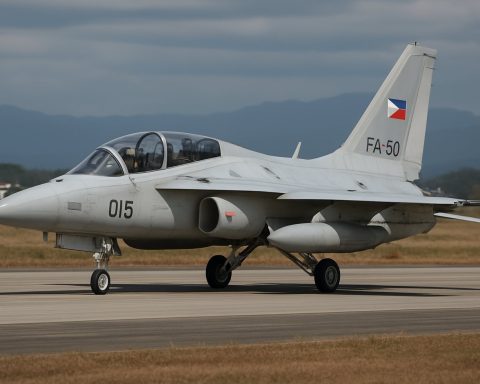- The Kaan fighter jet program highlights Turkey’s ambition for international collaboration, particularly with Indonesia.
- Discussions between Turkish President Erdogan and Indonesian President Prabowo Subianto focus on a strategic defense manufacturing alliance.
- The Kaan is a fifth-generation fighter jet, developed by Turkish Aerospace Industries and BAE Systems with advanced features comparable to the F-35.
- The program’s origins trace back to Turkey’s exclusion from the Joint Strike Fighter program due to its acquisition of Russian S-400 systems.
- The potential partnership with Indonesia and interest from nations like the UAE highlight Turkey’s growing influence in defense production.
- The Kaan program represents resilience, ambition, and a collaborative vision in international military aviation.
- This partnership illustrates a merging of defense strategy with diplomacy, aiming to forge a new era of aviation innovation.
Vast skies beckon as Turkey’s ambitious Kaan fighter jet program takes a bold step towards international collaboration. Recent developments hint at a future where the diplomatic skies of Ankara and Jakarta may converge, crafting a narrative of synergy and shared vision in military aviation. The sleek lines of the Kaan—a fifth-generation fighter cloaked in mystery and promise—could soon carry Indonesia’s aspirations alongside Turkey’s determination.
The interest from Indonesia emerges after President Prabowo Subianto’s discussions with Turkish President Recep Tayyip Erdogan. Binding aspirations, the two leaders shared a vision where Indonesia contributes its ingenuity to the Kaan fighter project, echoing not just diplomatic synergy but a strategic alliance in defense manufacturing. Their dialogue resonates through recent accords that span culture, disaster management, and media, forging a foundation of cooperation that extends to the skies.
Turkey’s voyage into fifth-generation fighter development had a turbulent start. Its involvement in the Joint Strike Fighter (JSF) program met an abrupt end in 2017. The rift emerged when Turkey embraced the Russian S-400 air defense systems, raising concerns over potential security vulnerabilities associated with sharing the F-35’s sophisticated technologies. Left without a partner in the skies, Turkey redirected its focus inward, sparking the creation of the homegrown Kaan.
Crafted by Turkish Aerospace Industries in collaboration with BAE Systems, the Kaan promises advanced capabilities. While much of its design remains shrouded in secrecy, glimpses reveal features such as internal weaponry, drone control, and ground attack capabilities, rivaling the prowess of the American F-35. The prototype’s recent display in Abu Dhabi attracted global attention, hinting at a future where nations unite their expertise.
As Erdogan imagines a collaborative future, Indonesia’s willingness to partake in this venture amplifies his vision of elevating Turkey to a leader in defense production. Such a partnership could forge pathways for other nations seeking participation. The Kaan program, standing at the precipice of a new era, invites countries like the United Arab Emirates, which have already shown interest, to walk alongside in crafting a legacy of innovation.
Much rides on these unfolding diplomatic and industrial interactions, yet the skies remain the limit. If executed, this partnership not only outlines a defense strategy but sketches a broader world view where defense and diplomacy soar on the same wings.
In the chaotic theater of international defense, the Kaan series emerges as a testament to resilience and ambition—transformative, collaborative, and distinctly visionary—ready to paint its tales not just in the clouds above, but in the annals of global aviation history.
Inside Turkey’s Kaan Fighter Jet: A New Era in Defense Collaboration
As Turkey and Indonesia set their sights on a groundbreaking defense partnership, the ambitious Kaan fighter jet program emerges as a pivotal player in this strategic alliance. This collaboration signifies a broader geopolitical shift, reflecting a synergy between Ankara and Jakarta that extends beyond aviation into a comprehensive defense and cultural partnership.
The Kaan Fighter Jet: Features and Advanced Capabilities
The Kaan, developed by Turkish Aerospace Industries in conjunction with BAE Systems, aims to rival the cutting-edge American F-35. Here are some key features and capabilities:
– Stealth Technology: While details remain mostly classified, it is suggested that the Kaan incorporates advanced stealth technology to reduce radar cross-section, enhancing survivability in contested environments.
– Internal Weaponry: The aircraft is likely equipped with an internal weapons bay to maintain a stealth profile during missions, similar to other fifth-generation fighters.
– Drone Control: Unique to the Kaan is its ability to control drone swarms, providing a tactical advantage in reconnaissance and combat scenarios.
– Multifunctionality: The fighter jet is designed for a variety of roles, including air superiority, ground attack, and electronic warfare, making it a versatile addition to any air force.
Strategic Implications and Global Interest
The burgeoning partnership between Turkey and Indonesia is set against the backdrop of a complex geopolitical landscape. As these nations collaborate on the Kaan project, several implications arise:
– Regional Power Shift: By advancing their own fifth-generation fighter capabilities, Turkey and Indonesia could potentially alter the balance of power in their respective regions.
– Expansion of Defense Industries: The collaboration provides opportunities for technology transfer, skill development, and economic growth as both countries aim to enhance their defense production capabilities.
– Potential Partnerships: Nations like the United Arab Emirates have shown interest in the Kaan program, hinting at the potential for a broader coalition of countries participating in or adopting the platform.
Addressing Security Concerns
The journey toward the Kaan project wasn’t smooth, as Turkey faced significant challenges. After being expelled from the Joint Strike Fighter (JSF) program due to its acquisition of Russian S-400 systems, concerns lingered about security and technology sharing. In response, Turkey has doubled down on developing indigenous systems to mitigate reliance on external sources.
Market Forecasts and Industry Trends
The defense aviation sector is witnessing a trend where nations are increasingly seeking self-reliance in defense capabilities. The Kaan project is indicative of this trend:
– Market Growth: According to a forecast by the Stockholm International Peace Research Institute (SIPRI), the global defense market is expected to continue expanding, with countries investing heavily in next-generation technologies.
– Technological Innovation: Emphasis on indigenous development is likely to spur innovation, leading to advancements in AI, cyber defense, and autonomous systems.
Actionable Recommendations
1. Stay Informed: For those interested in defense technologies, following developments in the Kaan project provides insights into innovations in stealth and drone capabilities.
2. Policy Considerations: Analysts and policymakers should consider the strategic implications of such alliances, as they may impact regional and global security dynamics.
3. Career Opportunities: As demand for experts in aerospace engineering and defense technologies grows, individuals might consider careers in these rapidly developing fields.
For further insights into global aviation trends, visit Boeing and Lockheed Martin.
The Kaan project is a testament to Turkey’s resilience and ambition in crafting a visionary future in defense. As countries seek partnerships and innovation, the skies are just the beginning of what they can achieve together.







